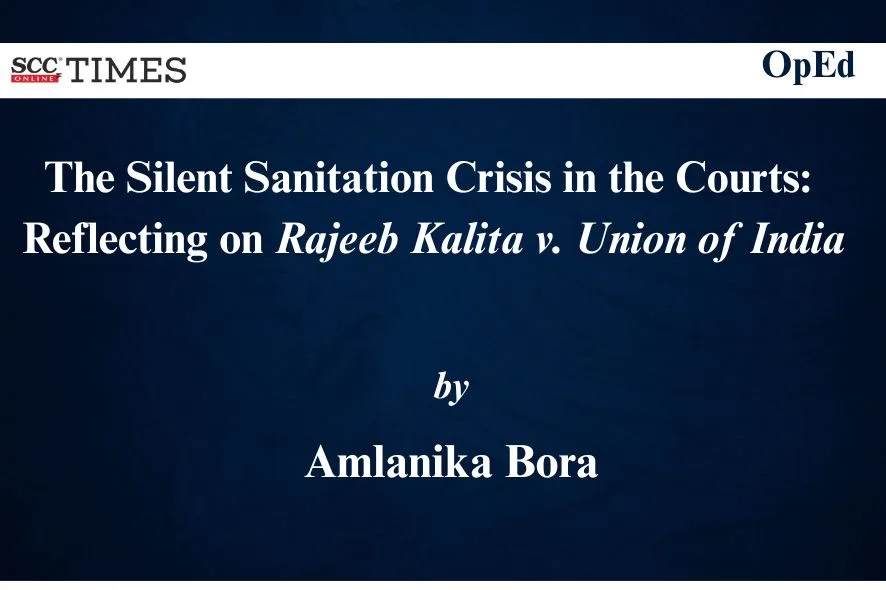A court premise is a space that serves as the physical setting for the administration of justice. The basic and vital part of court infrastructure is a well-furnished courtroom, which includes chambers, restrooms, drinking water, waiting areas, judicial lockups, record rooms, Bar spaces, staff offices and facilities geared towards the needs of the public.1 Yet, for the people accessing court premises-litigants, lawyers, court staff and even Judges — the experience of traversing the justice delivery system in India is often marred by an unspoken indignity: the lack of access to adequate toilet facilities — sometimes non-availability, sometimes non-functional sometimes unhygienic, sometimes non-inclusive.
The infrastructural neglect in the justice delivery system is more than a logistical fiasco; it is an alarming concern that contradicts with the constitutional mandate of upholding life and dignity. In the landmark case of Rajeeb Kalita v. Union of India2, the Supreme Court of India (SC) addressed this long-neglected issue. The SC uphold that the inadequate sanitation facilities in court premises violate the fundamental right to life and dignity protected under Article 213 of the Constitution of India4 (COI). This judicial narrative, progressive in tone and firm in its directives, unmasks the persistent neglect towards the basic requirements that underpin the administration of justice in India.
Court premises without toilets: A deep-rooted problem
Rajeeb Kalita case5 originated from a public interest litigation, in which the poor sanitary condition across the Court premises in the State of Assam was highlighted by a practising Advocate Rajeeb Kalita. In response, the SC took suo motu cognizance and directed High Courts across India to submit tabular statements on affidavit demonstrating the status of availability, accessibility and maintenance of separate toilet facilities for different genders.6
A detailed report prepared by the “Centre for Research & Planning” of the SC depicted a bleak picture. For instance:7
(a) The Andhra Pradesh High Court needs a threefold increase in toilet facilities.
(b) Twelve High Courts reported non-availability of toilets in District Court premises for Judges, staff, lawyers and litigants.
(c) Nearly 20% of District Court premises lack separate toilets for women.
(d) Only 6.7% of toilets are equipped with sanitary napkin vending machines.
(e) Several existing toilets are dysfunctional, with broken doors and inadequate water supply.
The judgment emphasised that Court infrastructure must not just serve administrative needs but mirror constitutional mandates and public dignity.
Sanitation as a component of environmental and gender justice
Sanitation is not just a public health issue — it is a matter of human dignity, privacy, gender equity, environmental justice and overall well-being of the people. The recognition of the right to sanitation (RTS) is woven into the fabric of both Parts III and IV of the COI.8 Judiciary through its liberal interpretation expanded the ambit of Article 219 which ensures the right to life to include the RTS within it. Furthermore, the RTS is interlinked to Article 17 (abolition of untouchability)10, Article 21-A (right to education)11 and several directive principles of State policy, being an element of socio-economic justice. More specifically, Articles 39(e)12, 39(f)13, 4214, 4715 and 48-A16, which direct the State to ensure health, humane work conditions, public health, and protection of environment-make sanitation a key element of social justice and constitutional governance.17
The SC in Rajeeb Kalita case18 underscored the heavy toll of the sanitation related infrastructural neglect on women, transgender persons, persons with disabilities (PwDs) and socio-economically disadvantaged groups. Despite the existence of the “Harmonised Guidelines and Standards for Universal Accessibility in India, 2021”19, court premises have consistently failed to incorporate universal design standards. Additionally, this institutional overlook goes against the “Transgender Persons (Protection of Rights) Act, 2019”20.
Thus, Rajeeb Kalita case21, bridging the gaps between institutional justice and individual bodily dignity, makes it clear that the rights must be actualised in real, physical spaces — not just in legal texts.
Global commitments, local failures
India’s international commitments indicates that it has an obligation to fulfil RTS. India is a signatory to the International Covenant on Economic, Social and Cultural Rights (ICESCR) which under Article 11(1) implicitly encompasses RTS within the ambit of adequate standard of living.22 Additionally, India supported the United Nation General Assembly Resolutions (UNGA Resolution) 64/292 which explicitly recognised the RTS in 201023 and UNGA Resolution 70/169 which recognised water and sanitation as distinct rights in 2015.24
Thus, failure to provide basic amenities pertaining to sanitation within the country’s justice delivery institution directly contravenes its international commitments. Note that the disparities between the global obligations and the lived reality within the judicial premises reflect a blind spot in infrastructure, accountability and governance.
Precedents that paved the way
Notably, Rajeeb Kalita case25 does not emerge in a legal vacuum. The judgment stands on the shoulders of various landmark judicial pronouncements that have progressively interpreted the right to life and dignity on various occasions and carved out a space for RTS. For instance, the SC in Francis Coralie Mullin v. State (UT of Delhi)26 held that the right to life under Article 21 includes the right to live with human dignity. Similarly, in Bandhua Mukti Morcha v. Union of India27, the SC linked degrading work conditions to violations of fundamental rights. Notably, in Municipal Council, Ratlam v. Vardichan28 the SC compelled the municipality to provide sanitation facilities, recognising public sanitation as a component of environmental and public health rights. In Virender Gaur v. State of Haryana29, the SC acknowledged that a hygienic environment, inclusive of sanitation, is basic requirement to enjoy life and dignity.
Thus, these judicial pronouncements laid the jurisprudential framework that allowed Rajeeb Kalita case30 to connect the dots between sanitation, dignity, environment and access to justice.
The judiciary’s directive: A blueprint for action
The SC in Rajeeb Kalita case underscored the nexus between the Court infrastructure and sanitation in the following words:31
10.2. Courts should not be places, where basic needs, such as sanitation, are overlooked and neglected. The absence of adequate washroom facilities undermines equality and poses a barrier to the fair administration of justice.
Accordingly, the Court issued concrete and actionable directions, which include:32
(a) Ensuring separate and inclusive toilets for women, transgender persons, and PwDs by all the High Courts (HCs) and State Governments/Union Territories (UTs) in India.
(b) Monitoring the availability and accessibility of these facilities to everyone within the Court premises by the HCs in India.
(c) Forming of a monitoring committee in all the HCs under the chairmanship of a Judge nominated by the Chief Justice and other members.
(d) Formulation of a comprehensive plan of action to implement various tasks pertaining to sanitation, which includes ensuring regular maintenance of the toilets, ensuring functioning and stocked sanitary pad dispensers in women, PwD and transgender toilets.
(e) Framing a complaint/redressal mechanism for expeditious reporting of dysfunctional toilets and immediate renovation of the same, etc.
(f) Allocation of dedicated funds for toilet construction and maintenance by the State Governments/UTs.
Thus, the Court redefined the significance of court premises not as an administrative afterthought, but as a core component of the justice delivery system.
Conclusion: Let space mirror the spirit of justice
The sanitation crisis in India’s court premises paints a stark picture of the structural indifference to the very people the system is meant to serve and ensure guarantee to their basic rights. It makes us question about our visibility and voice, makes us rethink: whose needs are legitimised in our public institutions!
Let us not forget what Rajeeb Kalita case33 has crystallised: The path to equitable justice starts not just in legal arguments and verdicts, but in physical spaces that affirm the dignity of every individual who walks through the door of justice.
*Assistant Professor, School of Legal Studies and Governance, Vidyashilp University, Bengaluru. Author can be reached at: amlanika.b@vidyashilp.edu.in, amlanika.bora@gmail.com.
1. Centre for Research and Planning, State of the Judiciary: A Report on Infrastructure, Budgeting, Human Resources, and ICT, 17-19 (Supreme Court of India, 2023).
3. Constitution of India, Art. 21.
8. Amlanika Bora, A Study of Right to Sanitation with Special Reference to Kamrup Metropolitan District of Assam (Ph.D. thesis, W. Bengal Nat’l Univ. of Juridical Scis., 2025).
9. Constitution of India, Art. 21.
10. Constitution of India, Art. 17.
11. Constitution of India, Art. 21-A.
12. Constitution of India, Art. 39(e).
13. Constitution of India, Art. 39(f).
14. Constitution of India, Art. 42.
15. Constitution of India, Art. 47.
16. Constitution of India, Art. 48-A.
17. Amlanika Bora and Sanjay Kumar, “Right to Sanitation in India through the Lens of Judiciary”, (2022) 4(1) CMR University Journal for Contemporary Legal Affairs 125.
19. Ministry of Housing and Urban Affairs, Government of India, Harmonised Guidelines and Standards for Universal Accessibility in India (2021).
20. Transgender Persons (Protection of Rights) Act, 2019.
22. International Covenant on Economic, Social and Cultural Rights (adopted 16-12-1966, entered into force 3-1-1976) 993 UNTS 3 (ICESCR), Art. 11(1).
23. UN General Assembly, The Human Right to Water and Sanitation, UN Doc. A/RES/64/292 (28-7-2010).
24. UN General Assembly, The Human Rights to Safe Drinking Water and Sanitation, UN Doc. A/RES/70/169 (17-12-2015).



